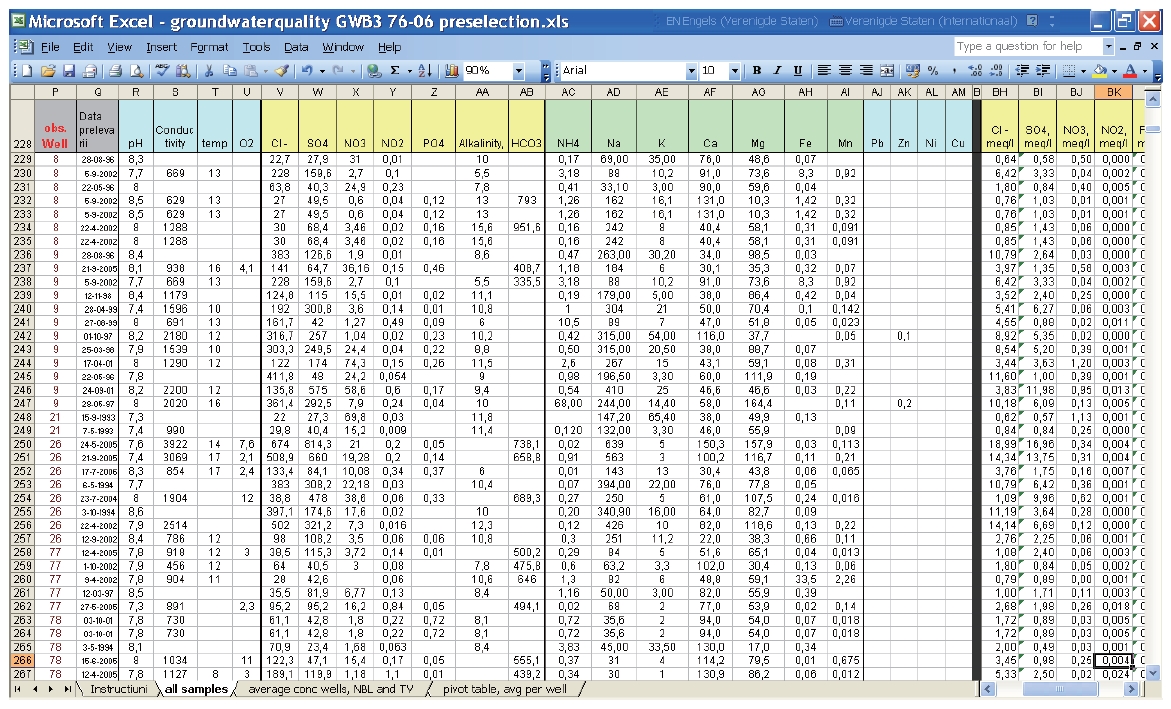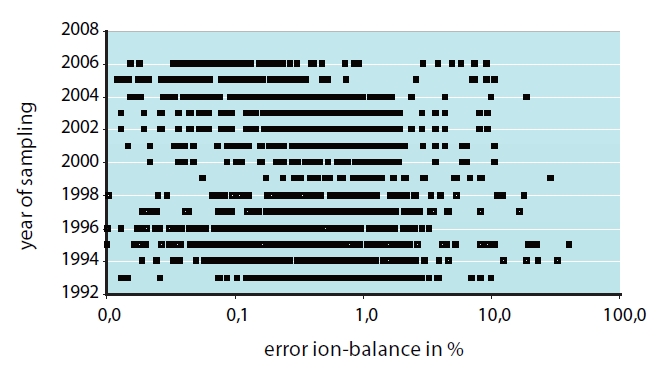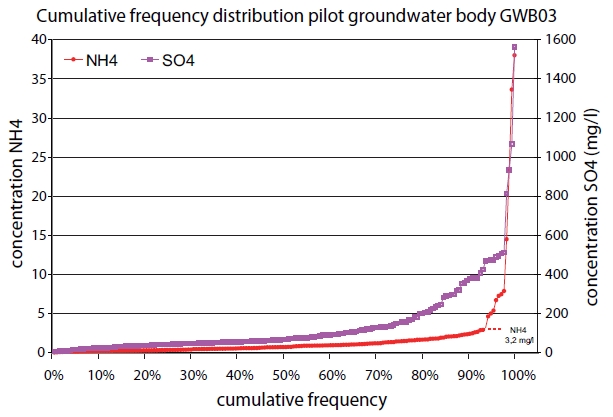



Romania aims to adopt and implement the European Union’s legislation, also including that for the field of water management. Like other countries, groundwater in Romania is locally polluted from point sources, such as leaking landfills, as well as from diffuse pollution sources, include fertilizers, pesticides and leakages from sewers, in urbanized areas. Diffuse pollution can also occur indirectly, by over-exploitation of groundwater wells, resulting in salt water intrusion, as well as from mining and exploitation of mineral aggregates. Romania has quite an intensive monitoring scheme to measure groundwater quality in phreatic and confined aquifers. The purpose of the work resumed in this paper was to derive natural background levels (NBL) for groundwater in order to distinguish the natural elevated concentrations of some substances (natural phenomena) from point and diffuse pollution (anthropogenic phenomena). Based on these NBLs, threshold values (TV) for groundwater will be set according to the requirements of the European Water Framework Directive and the related Groundwater Directive. This paper describes the results of a study for the derivation of NBL and TV in a pilot Groundwater Body. Also, the process and draft results for extrapolating this work for all Romanian groundwater bodies is explained, as well as points for future consideration with respect to monitoring and management.
The objective of the Water Framework Directive (WFD) [1] is to achieve good status for all surface and groundwater bodies. Within a river basin, member states have to delineate so-called water bodies and groundwater bodies. Surface water bodies are lakes, reservoirs, streams, rivers and coastal water. A body of groundwater means a distinct volume of fresh groundwater within an aquifer or aquifers. Specifications for their protection are set in the Groundwater Directive (2006/118/EC). Member states have to analyze the pressures and impacts of human activities on the quality of groundwater, with a view to identifying groundwater bodies at risk of not achieving the WFD environmental objectives. This assessment has to evaluate risks linked to water uses (especially human consumption) and interactions with associated aquatic and terrestrial ecosystems.
Since 1970, water management in Romania has been based on the concept of integrated river basin management of water resources (both surface and ground waters, both quality and quantity). The conservation, development and protection of water resources in Romania are currently regulated by Water Law (no. 107/1996), which was amended in 2004 and 2006 to implement the provisions of the WFD. Any water use is subordinate to obtaining a permit (before execution of all works on water or influencing water) and a license (before exploitation begins). Water supply for human consumption prevails over other uses. Discharges of waste water into groundwater are forbidden, and only under strict conditions may waste water and mine water be injected into very deep layers. The latest amendment with respect to groundwater quality was the establishment of a new monitoring system based on the groundwater protection objectives. These objectives are the progressive reduction of discharges, emissions and losses of the dangerous priority substances into water bodies, ceasing or phasing out of priority hazardous substances used in industry, to ensure good water quality supply for human consumption.
2. Pilot Study Groundwater Banat
In January 2007, a pilot project was started in Romania [6, 7] for, among others, the derivation of NBL and TV. This project was funded by the Dutch Ministry of Economic Affairs (EVD) within the Netherlands Pre-accession Programme-Environment Facility. The project was performed by a consortium under the lead of Grontmij Nederland, in partnership with Witteveen+Bos, Ecorys and BDO Conti Audit. They worked in close cooperation with the specialists of the Romanian Ministry of the Environment, National Administration "Apele Romane," Banat Water Directorate and the National Institute of Hydrology and Water Management. The project is referred to as the Banat groundwater project, but the full title is "Establishing measures to rehabilitate the polluted groundwater altered due to landfill, in order to reach the environmental objectives required by the WFD."
The main purpose of the study was to develop a method to set up a database structure on groundwater quality and; using that database, to derive NBL and TV. The method was tested on a pilot groundwater body, which should be suitable for the derivation of NBL and TV of the other Romanian groundwater bodies.
To develop a database and derive NBL and TV, the following steps have been carried out:
First, a pilot groundwater body was selected.
After collating an inventory of available chemical data, a simple database structure for the groundwater quality data was developed using the spreadsheet program, Excel. All hydrochemical data of the pilot groundwater body were included into the database.
The data were checked using calculated ion balances and calculated conductance. Errors or suspect samples were identified using auto filters for ion balances, measured and calculated conductance, illogical redox phenomena, extreme low or high concentrations and time series.
NBL and TV where derived following the EU-guideline on TV and using checked (reliable) data.
Working sessions were organized to explain the developed database and derivation of the NBL and TV to the other water directorates. After the databases for their groundwater bodies had been established, the results (draft NBL) were discussed at working sessions with the 11 water directorates, the National Institute of Hydrology and the Romanian Ministry of Environment.
After the Water Directorates had completed and improved their databases, The National Institute of Hydrology and Water Management collected these databases and evaluated the draft NBL and TV of the groundwater bodies from a hydro chemical and hydro geological perspective. For some groundwater bodies, NBL and subsequent TV were adjusted to take into account their specific hydro geological situations.
This paper presents the methods and results of the derivations of the NBL and TV for the pilot groundwater body and the resulting NBL and TV for the other vulnerable groundwater bodies in Romania.
The groundwater body ROBA03 (GWB03) was selected as the pilot for this study. This body is allocated to the Banat Water Directorate (see Fig. 1- right), where derivations of the NBL and TV were very urgent due to the presence of a large landfill (to be closed by the end of 2008), which had possibly polluted the groundwater. This body consists of sandy deposits, partly covered by clay and loam. The maximum admitted concentration (MAC) according to Law no. 458/2002 concerning the quality of drinking water) for NH4 and NO3 had been exceeded; therefore, the body was qualified as at risk during the characterization phase [5].
The Groundwater Body, Banat, is located in the Western and South-western parts of Timisoara Plain, which includes the floodable plains formed by the rivers Bega Veche, Bega, Timis, Barzava, and Moravita. The topography is featureless, with small slopes of less than 2%. The Pleistocene and Holocene deposits include alluvial fans with gravel, sands and clay. The dominant texture of the Western part of the Groundwater Body is sand. The soils that overlay the aquifers are clays, sandy- and silty clays, silts and argillaceous silts. The thickness of the aquifers varies substantially from 3 to 27 m. The hydraulic conductivity (k) ranges from 10 to 50 m/day, and average transmissivity (T) is 100 m2/day; the hydraulic gradients generally follow the ground surface. Precipitation is the main source of groundwater, combined with recharge from meadow rivers during high water and floods. During dry periods, rivers drain naturally to the phreatic layer, with the exception of Bega River, which permanently supplies the phreatic aquifer as a result of its high embanked flow.
The starting point groundwater quality database was established by the application of a uniform database structure for all 11 Water Directorates. The databases were prepared by employees of the Water Directorates. Therefore, a simple database structure was developed in Excel, taking into account that it should be easy to understand, accessible and suitable for the development of transparent overviews and easily checkable data. Each row within the database contains one sample, with the columns containing information about the sample (date, well number, depth of the screen, etc), the analytical results (concentrations of substances) and simple calculations of ion balances and other calculation that can be used to check the data. Fig. 2 shows the how the data were organized in Excel.
For the pilot groundwater body ROBA03, all hard copy chemical reports from 1976-2006 were entered into the Excel database, which resulted in a dataset with 450 chemical analyses of 3,300 samples from 207 observation wells; all these wells were monitoring wells (no production wells).
Step c) Quality control
As with every database, errors can and will occur, especially if they contain as many entries as ROBA03. With respect to the groundwater quality data, errors can occur when concentrations listed in hard copy reports are not correctly entered into the Excel database or when they are placed into wrong fields. Other errors arise from wrong or unrepresentative analytical results. These can be caused by a range of factors, such as faulty laboratory equipment, incorrect conditioning of samples and mistakes, or the use of incorrect procedures during sampling [8]. All these errors can have a significant impact on the calculated NBL. The reliability of derived NBL and subsequent TV depends very much on the reliability of the chemical database [9].
Step d) Derivation of NBL and TV
Based on the EU (draft) Guidance document [10] "Groundwater Chemical Status and TVs, version 2.0 [EC, 25-10-07]" and BRIDGE project recommendations [9, 10], the data were studied and analyzed. After checking the data and removing the unreliable samples, the average concentration values per monitoring well were calculated for the period 1993-2007. Wells with anthropogenic inputs were identified using criteria for the average chloride, nitrate and Oxidation Capacity. The NBL was then calculated as the 90 percentile value of the remaining (not anthropogenic influenced) wells.
A high Chloride concentration is the first criteria used to indicate an anthropogenic influence, which often results from inputs such as the use of fertilizers, de-icing salts or leakage from sewers. High chloride concentration can also be caused by salt water intrusion (from the sea or from underlying marine deposits or salt diapires), but in general groundwater bodies are delineated by selecting only aquifers that contain fresh groundwater. Following the EU-guidance, wells with chloride concentrations exceeding 200 mg CI/L are considered as anthropogenic.
Nitrate is another indicator of anthropogenic inputs, because natural fresh groundwater resources seldom contain concentrations higher then 5 to 10 mg/L NO3. Following the EU-guidance, wells with nitrate concentrations exceeding 10 mg/l NO3 are considered as anthropogenic.
[Table 1.] NBL calculated for the pilot GWB03 using the 3 methods
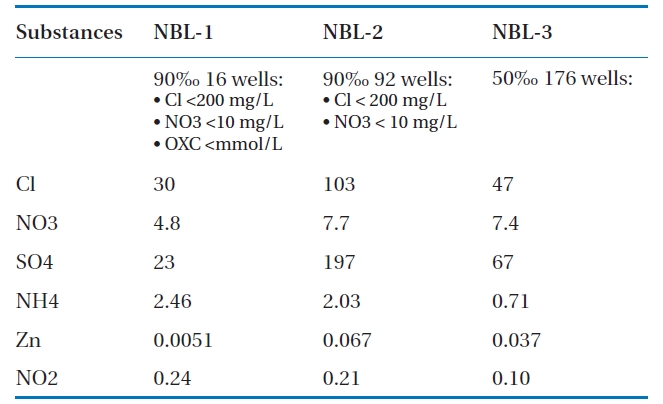
NBL calculated for the pilot GWB03 using the 3 methods
The use of OXC provides insight when nitrate reduction in association with pyrite oxidation is a relevant process: contamination of groundwater by nitrate is masked when nitrate reduction occurs. In pyrite containing soils, nitrate disappears and N2, ferrous iron and sulphate appear; in the following equation: FeS2(s) + 14NO3-(aq) + 4H+ ??7N2 + 5Fe2+ + 10SO42- + 2H2O. To take this degradation into account, the oxidation capacity (OXC) can be used as an alternative indicator of nitrate inputs. OXC is calculated from nitrate and sulphate, via OXC (meq/l) = 7[SO4] + 5[NO3], where [i] is the concentration of species i in mmol/L. The values of 7 and 5 refer to the amount of electrons transferred when NO3 is reduced toN2 and SO4 to FeS2, respectively. Following the EU-guideline, wells with OXC above 2 meq/L were considered to contain anthropogenic inputs.
Using the NBL as a starting point, TVs were then proposed based on current quality standards in Romania for drinking water and surface water, because these are the relevant receptors within the groundwater body. If the NBL was lower then the quality standards, the lowest quality standard was chosen as the TV. If the NBL was higher then the quality standard, the TV was set a little higher then the NBL, in-line with the EU-guideline for the TV derivation.
The practical methodology derived within this pilot was adopted by all the Water Directorates to compose a database for all their groundwater bodies, study data, derived NBL and proposed TV based on the NBL [9, 11] and water quality standards for drinking and surface waters. In several workshops, draft results were presented and discussed by all the groundwater specialists involved.
The results from each Water Directorate were then gathered by the National Institute for Hydrology and Water Management, and studied further. For several groundwater bodies, the method for the TV derivation had to be refined to take into account the specific hydro geological conditions.
The next paragraphs present two special cases where derivation of the NBLs, and implicitly the TVs, did not follow the general procedure. In these cases, the TV and NBL were derived based on the study and interpretation of local geological and hydro geological conditions.
Groundwater data in specific areas within the Buzau-Ialomita Water Directorate revealed high contents of chloride in both shallow and deep aquifers. High chloride concentrations are caused by the presence of salt formations in the areas where natural groundwater recharge is occurring. Salts are being dissolved by infiltrating rainfall, which finally enter the aquifers through recharge. These specific areas of subsidence evolve in an arid climate, when waters and soils accumulate chlorides due to increased evaporation. For these groundwater bodies, the "chlorides" criteria were not used in the derivation of NBL, meaning that samples with a content of Cl >;200 mg/L were not eliminated. In these cases, the "nitrates" criteria were used with the correlation and distribution graphs. The NBL for chloride was derived at a level of 629 mg/L for ROIL07 - Campia Brailei groundwater body, and 169 mg/L for ROIL11 - Lunca Dunarii, sectorul Oltenita - Harsova groundwater body.
The second case refers to the ROPR02 groundwater body, which is along the terraces and meadows of the Prut River and its tributaries. In the Southern extremity of this groundwater body, in the Brates zone, peat horizons are present, which cause high contents of ammonia in the monitoring wells. During a first attempt to derive NBL, all the chemical analyses from all the monitoring wells within the entire groundwater body were taken into consideration. The strong influence of the high contents of ammonia in the Brates zone was obvious, as the NBL obtained for NH4 was 6.69 mg/L. This NBL value was not acceptable, because such a high TV would allow further deterioration in the rest of the groundwater body. Therefore, it was decided to exclude the Brates zone data from the calculation, with this zone considered unique and different from the rest of the ROPR02 groundwater body. In this way, the NBL obtained for NH4 was 4.45 mg/L. The particulars of the Brates zone are mentioned as motivation for the deviation from the methodology in the River Basin Management Plan.
[Table 2.] TVs derived for the Romanian GWB
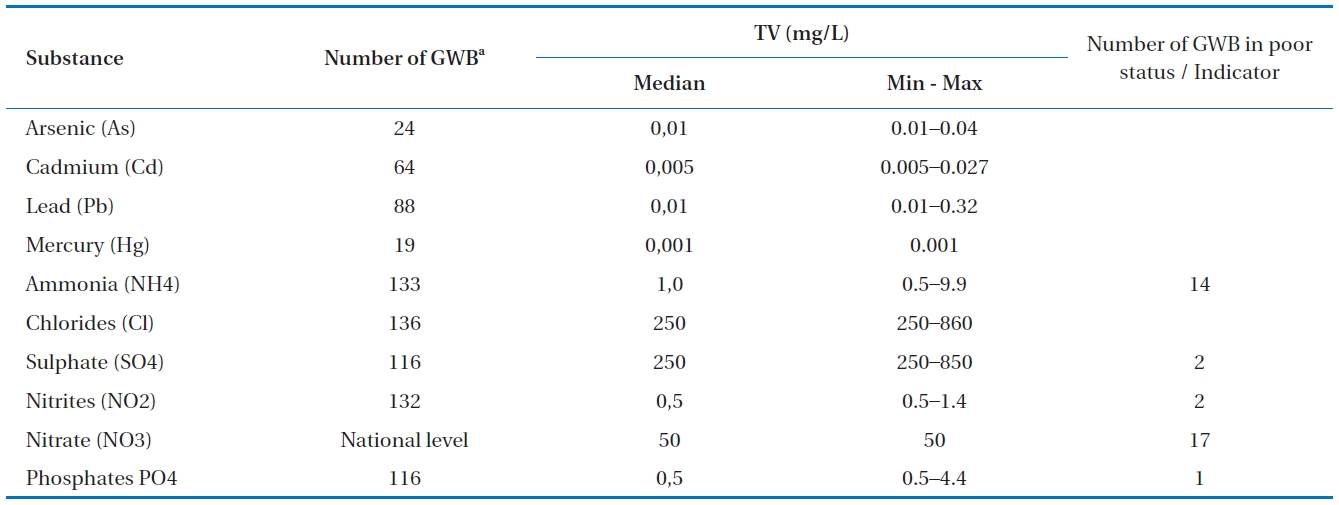
TVs derived for the Romanian GWB
The resulting TVs are presented in Table 2, as well as the number of groundwater bodies with a poor status with respect to each chemical indicator. Some of the groundwater bodies had a poor status due to several indicators. Like most European member states, the European standard for nitrate of 50 mg/L was adopted at a national level.
Most of the groundwater bodies having a poor status were noticed to be caused by NO3 or NH4, which likely to have been caused by the main source of groundwater pollution, i.e. diffuse pollution from agriculture.
The relatively large variations in the TVs could be explained by the very diverse and complex geological and hydro geological conditions in Romania.
Whether a lower TV for nitrate should be derived was also discussed, which would be reasonable for groundwater bodies that interact with surface waters, because the EU-standard of 50 mg/L was relatively high compared with the quality standard for nitrogen in surface waters. Conversely, the contribution of groundwater quality to the quality of surface water is often significantly lower then 100%; therefore, dilution can be taken into account. Such a derivation requires a very good understanding of the hydro-geological situations and interactions with surface water bodies.
Whether a lower TV for nitrate should be derived was also discussed, which would be reasonable for groundwater bodies that interact with surface waters, because the EU-standard of 50 mg/L was relatively high compared with the quality standard for nitrogen in surface waters. Conversely, the contribution of groundwater quality to the quality of surface water is often significantly lower then 100%; therefore, dilution can be taken into account. Such a derivation requires a very good understanding of the hydro-geological situations and interactions with surface water bodies.
As demonstrated in this paper, a good knowledge of groundwater chemistry and quality patterns is essential for developing sustainable environmental policy. Obviously, it serves to assess whether high concentrations are caused by human pollution or by natural hydro geological processes. Furthermore, NBL are also essential to understand and predict geochemical processes, such as degradation, sorption, related risks for plume propagation and possibilities for natural attenuation from leaking landfills and other pollution sites. This knowledge serves to optimize strategies for monitoring, evaluation of environmental policy to reduce emissions and in identifying efficient remedial measures. The work performed in this study is not the final product, but an important step in the ongoing process of enlarging our knowledge of the groundwater chemistry and NBLs. It will also contribute to future monitoring and management of groundwater in Romania. The NBL and TV’s will be very useful in the near future for surveying groundwater quality using an optimized monitoring network and to establish a starting point to reverse the upward trends in pollutant concentrations.


